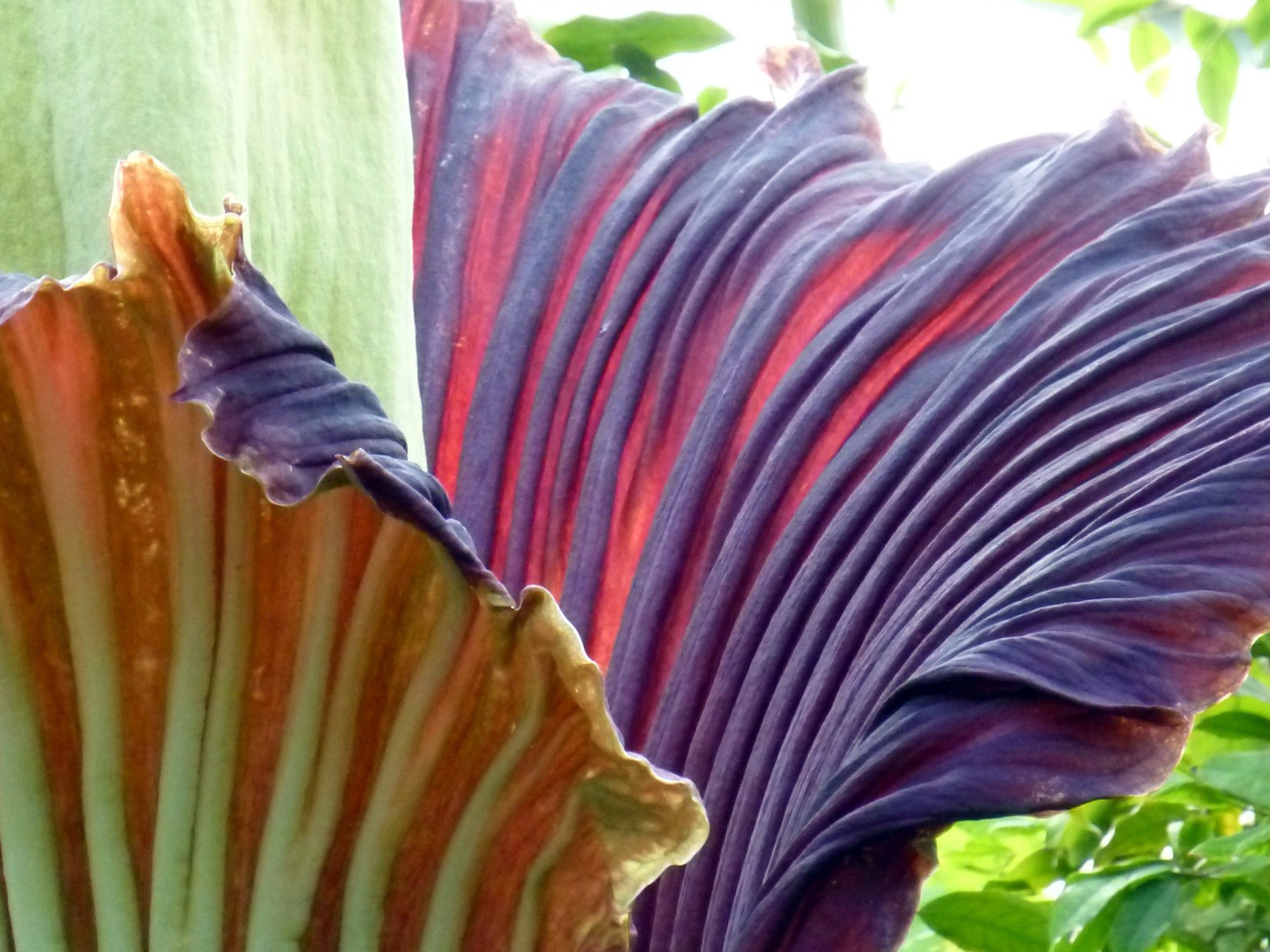
FAQs on Amorphophallus titanum
Frequently asked questions about Amorphophallus titanum
The plant was first introduced to the western world by Italian botanist Odoardo Beccari who found it on an expedition in 1878 and sent seeds & corms back to Italy, which were then shared with other Botanic Gardens.
The Titan Arum is native to the rainforests of Sumatra, one of the largest islands of Indonesia.
Plants were grown at selected gardens from the first seeds collected by Odoardo Beccari, and RBGE Kew successfully grew theirs to produce the first flower in cultivation in 1889.
Amorphophallus is a scientific name, derived from Ancient Greek and means ‘misshapen penis’. The plant has different common names, including ‘titan arum’ and ‘corpse flower’.
The seed was sown at Hortus Botanicus Leiden (in the Netherlands) in 2002 and the resultant corm (a type of tuber) was gifted to RBGE in 2003, at the size of a small orange. That makes New Reekie around 22years old!
This species is not known to be edible, but corms of other Amorphophallus species are used as a food source. A.konjac is known for its soluble fibre flour used to make low calorie ‘skinny noodles’.
When it was last weighed in 2010, our corm came in at a massive 153.95kg – about the same weight as 2 fully grown adults – and the largest ever recorded. Since 2010 the corm has more than doubled in size. After flowering the corm shrinks considerably and a new leaf builds it up again. However, we no longer lift from the pot to weigh it
Amorphophallus titanum requires specific conditions of high humidity and high temperature, and as a leaf can grow to the height of 6 metres plus – it would be difficult (but not impossible!) to grow this successfully at home. We are growing it in a Air-pot approx. 500 litre in the Lowland Tropics glasshouse, which is kept at 21-25°C during the day (minimum 19°C at night) and approximately 80% humidity.
At RBGE, we use a mix of free draining bark, pumice (volcanic rock pieces), sand, and charcoal. We feed the plant, when it is growing, with tomato fertilizer.
In Indonesia, the plant is locally known as the ‘corpse flower’, because it smells of rotting flesh. In the wild, the purpose of the smell is to attract pollinators (carrion beetles, flies and sweat bees) from miles away. The smell is strongest when the flower first opens and then quite quickly lessens so that it cannot be detected much the following day.
The biggest true flower in the world is Rafflesia arnoldii, but the titan arum is the biggest unbranched inflorescence (cluster of flowers). The tallest titan arum flower recorded was grown in Cibodas Botanic Garden, Indonesia, in March 2016 with a flower over 3.7m tall.
The flower opens when the female flowers are receptive to pollen; if they are pollinated the flower will close, so it could only last for one day. The first flower at RBGE was not pollinated and it remained open for 4 days, the second flower had pollination attempted and lasted for almost 7 days but is considered anomalous as the floral structures within were slightly malformed.
We are unlikely to pollinate the flowers this year. Though in the past pollen has been sent to us from Cambridge Botanic Garden, RBG Kew, Eden Project and Paignton Zoo.
If the plant is pollinated and pollination is successful, the plant will produce fruits, and seeds will develop over several months. Usually, the energy the corm expends to produce fruits results in the death of the plant; however, it has been known for the corm to survive and live on to produce further leaves and flowers.
If the plant is not pollinated it may well live to see another flower – though as we are now onto the third flower from the same corm there is not a lot of literature to tell us how it may behave. The corm may use up all of its reserve or it may manage to produce another leaf – only time will tell.
Yes. We took leaf cuttings from this plant in 2010, and they have already produced corms, and are currently in growth. We also have small plants that were grown from seeds produced at the Eden Project using pollen from our 2015 flower. We currently have a flower every 2-3 years.
The plants can be difficult to grow to flowering stage and they take about 7-10 years to reach maturity. We have been very lucky to have a stable corm which has produced a consistent flower every two years once matured, possibly due to the fact it has not, thus far, produced seed.
Usually the plant requires a period for both leaf growth and then dormancy which would mean at least a 3 year cycle but, perhaps due to the size of the corm, it currently has not had a fully dormant phase since first flowering in 2015.
The plant is becoming more common in botanic gardens; however in the wild, as of last year, it is classified as Endangered (EN) on the 1997 International Union for Conservation of Nature (IUCN) Red List of Threatened Plants, due to natural habitat loss.
The Amorphophallus titanum was studied as part of a joint project between Bogor Botanic Garden and the RBGE to re-assess its IUCN status. The Garden has strong links with South East Asia, and in particular Indonesia; we have been working in this part of the world for about 70 years. RBGE scientists and horticulturists have visited Sumatra, home of the titan arum, several times and are studying many plant families from the region.
Discover more
Botanics Recommends
-
Explore our range of unique gifts and more. Every purchase supports the Garden.
-
Explore our unique venues, suitable for every occasion
-
Discover a range of books inspired by the RBGE's work and collections
-
Cultivate your curiosity with our programme of courses for all ages and interests.
